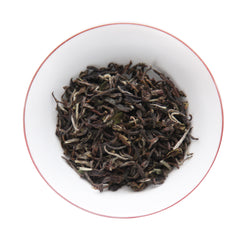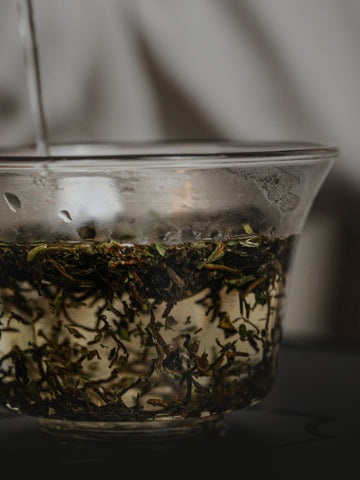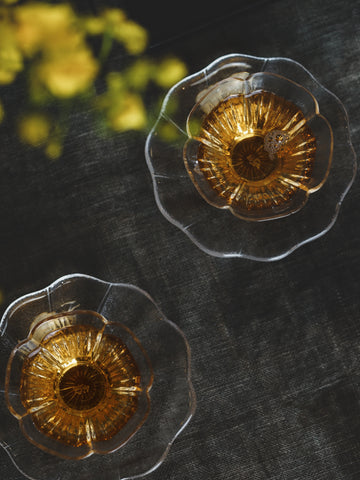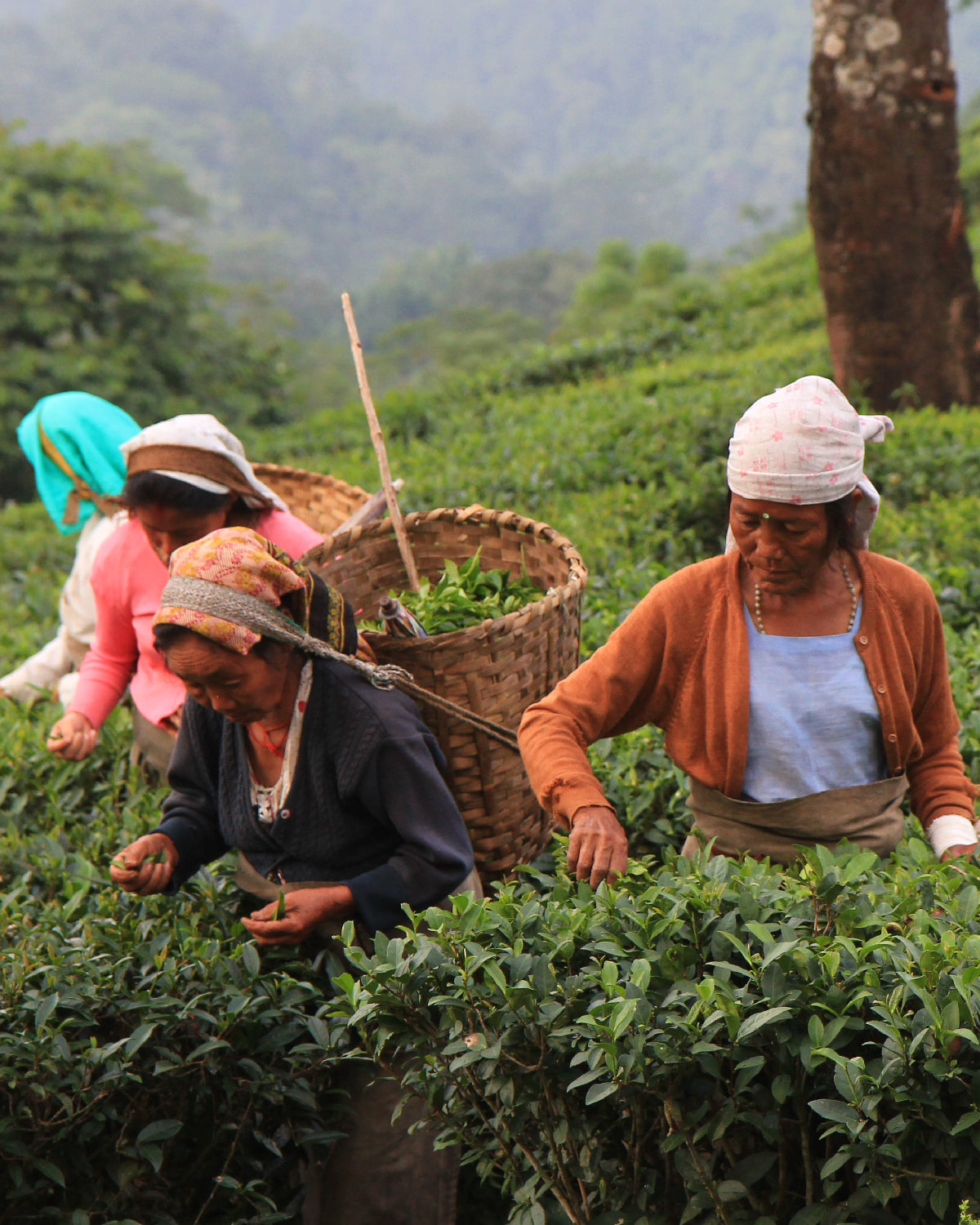In this article, we journey to the Himalayas to learn about Darjeeling, the Champagne of teas.
Famous for its rich muscatel flavour, Darjeeling is really something special. Its unique flavour is the result of a Chinese cultivar grown in Indian terroir at a high altitude, as well as the intricate harvesting and processing methods used.
Darjeeling holds a special place in my heart because it was one of the first regions I explored when I began sourcing tea. I visited Glenburn estate, which has been run by the Prakash family for more than a hundred years.

I still have vivid memories of that place. The estate manager took us around the tea gardens in his jeep, and we sat among the plants, drinking freshly made tea at sunset. It was pure bliss!
A brief history of Darjeeling tea
Nestled in the foothills of the mighty Himalayas, the Darjeeling region has been producing tea for centuries. While the C.s. assamica tea plant variety grows natively in Assam, the Chinese C.s. sinensis was first planted in the Darjeeling area in 1841 by Archibald Campbell of Britain’s East India Company.
After years of experimentation, tea producers in India learnt that the smaller leaf C.s. sinensis does better in higher elevations like Darjeeling and the larger leaf C.s. assamica is more suited to lower, warmer regions.

The explosion of demand for tea brought many employment opportunities for local people, and Darjeeling's population grew from less than 100 people in the 1830s to 95,000 people with 100 tea gardens in 1885. After Indian independence in 1947, the tea gardens were handed over to Indian tea producers, who continued to develop their expertise over generations.
What makes Darjeeling tea so special
Due to the area’s geographic limitations, remoteness, slower plant growth and inability to mechanise, Darjeeling tea producers couldn’t compete with other regions in terms of quantity or price, so they focused on quality.
They chose more organic methods that not only produced superior teas, but also helped protect the gardens from erosion and soil depletion.
Thus, whole leaf Darjeeling tea is known for its nuanced muscatel flavour that, unlike the more astringent CTC teas, can be enjoyed without milk or sweeteners.

Since 2004, the term ‘Darjeeling tea’ has been a registered geographical indication referring to teas produced on selected estates within Darjeeling and Kalimpong. Still, the market is full of “fake” teas produced in different regions masquerading as Darjeeling tea, which is why we works directly with farmers to ensure our teas are authentic.
Terroir
The geography of the land contributes to Darjeeling tea's signature flavour.
The tea grows on the hillsides of the Eastern Himalayas, between 600 and 2,000 metres in elevation. This particular climate of cool, dry winters and hot, monsoon summers encourages thick forest growth and slightly acidic soil that is rich in minerals and well-drained, due to the steep slopes—ideal conditions for tea growing.

In the spring, intense sunshine hits the cold crystalline mountain air to create the ‘Darjeeling mist’ that shrouds the gardens as they grow, providing the ideal environment for the C.s. sinensis to thrive.
Seasonal harvests
In Darjeeling, tea is harvested from March to November every year. Harvests are called "flushes".

First flush
- Harvest: March to May
- Flavour: Light, floral, muscatel
The first spring harvest comprises new, tender buds that have just emerged after the dormant winter period. Our Darjeeling First Flush is less oxidised and more “green” than most Darjeeling black teas, to let its delicate floral and fruity notes shine through.

Second flush
- Harvest: May to June
- Flavour: Strong, robust, muscatel
For the second flush, the plants have been exposed to more sunshine, so the flavour profile of the tea is stronger and more robust. Our Darjeeling Second Flush is a sweet, robust black tea (exclusively available to our teaCLUB members).

Autumn flush
- Harvest: October to November
- Flavour: Rich, malty, muscatel
When it comes to the last harvest of the year, the plants have been exposed to the monsoon rains and hot summer sun, which completely alters the flavour of the tea. It is the last crescendo given by the plants before they go dormant for winter. Our Darjeeling Autumn Crescendo is a rich and robust black tea that will warm you and carry you through the winter.

Darjeeling white tea

How to brew Darjeeling teas
Darjeeling tea is usually brewed Western style, in a teapot, but we also like brewing it in a gaiwan, as most high quality Darjeeling tea is whole leaf tea, so lends itself to the gongfu brewing process nicely.

Lighter Darjeelings
For Darjeeling Moonshine white tea and Darjeeling First Flush (a lightly oxidised tea comprising mainly buds) we recommend using a lower temperature range of 85-90°C to enjoy the more delicate nuanced flavours.
I also highly recommend cold brewing both these teas to see how the sweet, floral notes are emphasised. Simply put a few grams of tea in a jug with room temperature mineral water and let it sit overnight. In the morning, you’ll have a sweet, refreshing beverage to wake up to!
Stronger Darjeelings
For fully oxidised, more robust Darjeeling teas like Second Flush and Autumn Crescendo, you can go up to 98°C-100°C. They work nicely as iced teas, too— brew them hot then pour over some ice and add lemon and honey. Delicious!

After you finish reading this, I hope you try our Darjeeling teas, so you can experience the variety of flavour on show. May you find a few moments to connect with nature, both in the great outdoors and in your teacup. As your tea leaves unfurl, drink in the crisp Himalayan air and the warm Indian sunshine that nurtured them, and give thanks to the leaves, in turn, for nurturing you.



Leave a comment